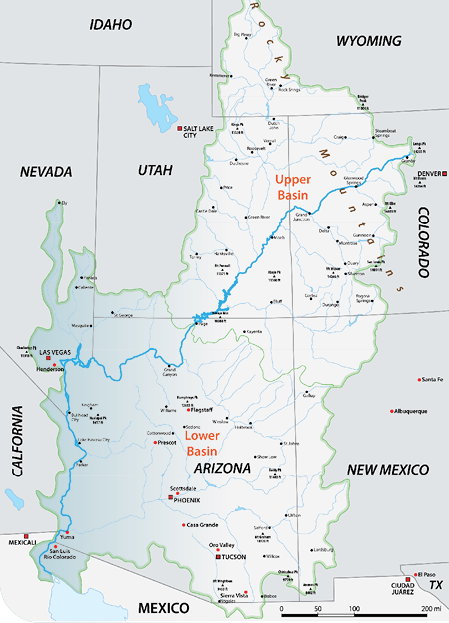At Rowland Water District (RWD), we understand the importance of knowing where your water comes from. RWD secures most of its water from imported sources including the State Water Project and the Colorado River. The Colorado River is a complex water delivery system that serves seven U.S. states. The Upper Basin includes Colorado, New Mexico, Utah and Wyoming, while the Lower Basin includes California, Arizona and Nevada.
Frequently Asked Questions
Why is the Colorado River important to California?
The Colorado River is an integral part of the water supply in California. Currently, the river is overextended. The river includes four lakes, and the two largest — Lake Powell and Lake Mead — are declining. It’s going to take a statewide reduction in how much water we take from that system to aid in its recovery.
The Colorado River not only supplies us with water but also with clean power through hydrogeneration. Energy generated at the Hoover Dam powers parts of Los Angeles. With declining water levels, this power source is under threat too.
California, especially Southern California and RWD, has relied on a combination of State Water Project (SWP) allocations and Colorado River water for decades. They have traditionally provided a safeguard for one another. With the declining conditions of the river, this may no longer be the case. While California is currently benefiting from a prior wet season after years of consecutive drought, the time to address the Colorado River crisis is now.

Tell me about the history of the Colorado River.
Some of the earliest water rights to the Colorado River were established when farmers moved into the Coachella Valley and used the water for their land — long before the state and federal government became involved in the river’s management. The Colorado River saw real development during the Roosevelt administration when a series of dams were constructed for storage and power generation for the growing West. Lake Mead became the largest reservoir west of the Mississippi.

How has California’s growth impacted the Colorado River?
The Metropolitan Water District (MWD) — the largest supplier of treated water in the United States and the water purveyor for Southern California’s most heavily populated regions — has the smallest allocation of Colorado River water of all seven states at 550,000 acre-feet. However, their allocation of SWP water is much larger at 49 percent.
While these figures have allowed Southern California to grow, the state has grown too large for this to be sustainable. The greater Los Angeles area conserved water and implemented major conservation initiatives that have resulted in water usage levels from 1968 while supporting a population of 2 million additional people. Under these constraints, we’re forced to use less Colorado River water.
What are some of the pressures and tensions that affect the Colorado River?
The federal government has asked the seven states that rely on the Colorado River to reduce water demand by 4 million acre-feet per year. MWD, along with Coachella Valley Water District, Imperial Irrigation District, and Palo Verde Irrigation District, offered to give up 400,000 acre-feet per year combined.
Certain states with junior water rights, such as Arizona and Nevada, have already taken curtailments. There is a sense of pressure and concern for sustainability and maintaining the agricultural sector of the economy. While several states developed a plan to recreate the Colorado River Agreement that was not California-friendly, it was not successful.
Given the severity of the situation, these curtailments may represent a new norm. Without these cuts, Lake Mead could reach a level where it can no longer generate power at the Hoover Dam. This is unprecedented — the Hoover Dam provides 19 percent of its power to Arizona, 23 percent to Nevada, and 58 percent to California.
What would California do without Colorado River water?
Without Colorado River water, California would be in a challenging situation. While most of California wouldn’t be affected, areas such as San Diego, Orange County, Los Angeles County, Ventura County, San Bernardino County and Riverside County would lack sufficient water supply.

What does the future hold for the Colorado River?
The wet year provided incredible relief in California, but it’s important to keep in mind that MWD was on the verge of considering severe cuts to allocations. Their emergency reserves were diminished to a level unseen for many years. At the same time, the federal government asked the seven states relying on Colorado River water to take cuts to their supply.
It’s highly probable that within the next decade, we will reach this tipping point again. The more we conserve, the longer we make the resources provided by this historic wet year last.
MWD has asked all its water agencies to remain at a 20 percent conservation level, largely due to the condition of the Colorado River.
What can you do?
With the current declining conditions of the Colorado River, conservation is vital — in California, it must become a way of life. It will take a combination of everyday changes and large-scale effort to make an impact. Here are a few ways you can help.
Landscape your yard with California native and drought-tolerant plants
Replace your traditional sprinklers with drip irrigation
Only use a hose with an automatic shutoff nozzle
Use a broom instead of a hose to clean patios, driveways and sidewalks
Check to make sure faucets are not dripping
Run the dishwasher only when full
Upgrade to a high-efficiency washing machine
Install a low-flow showerhead
Visit www.YourWaterFootprint.org to learn more about your water footprint and ways to reduce water waste.
For rebates to save water and money, visit: socalwatersmart.com



